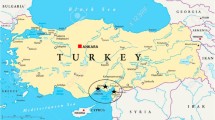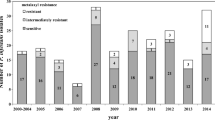Abstract
Severe late blight epidemics in Tunisia in recent years prompted population studies on the pathogen responsible for this disease, Phythophthora infestans. Characterisation of 165 Tunisian P. infestans isolates collected from 2006 to 2008 was performed for the mating type and mt haplotype, while subsets were analysed for metalaxyl sensitivity (n = 65), virulence on differential set of 11 R genes of Solanum demissum (n = 31), aggressiveness on cv. Bintje (n = 36) and measurement of the radial growth on agar medium at three temperatures (n = 38). Most isolates from potato and all isolates from tomato had the A1 mating type. The A2 mating type was detected in the north-east and northern areas, but not in the north-west. All the A2 mating type isolates were metalaxyl resistant and seem to be part of a new generation of the P. infestans isolates which are more aggressive, with more complex races, and tolerant to higher temperatures. The increased severity of epidemics during 2006 to 2008 can be attributed to favourable weather conditions during growing seasons, adaptation of new genotypes, widespread phenylamide resistance in potato production regions and most probably incorrect spray programmes. In contrast to the presence of complex pathotypes in two major potato crop regions (north-east and northern areas), the P. infestans population detected in the other regions and in tomato crops was still relatively simple. Compared with the situation in Europe and the American continent, or even compared with neighbouring countries such as Algeria, the genetic changes in Tunisia are still comforting and require strict management decision on late blight control to avoid the spread of new P. infestans populations from Europe or neighbouring countries.








Similar content being viewed by others
References
Andrivon D, Pilet F, Montarry J, Hafidi M, Corbière R, Achbani EH, Pellé R, Ellissèche D (2007) Adaptation of Phytophthora infestans to partial resistance in potato: evidence from French and Moroccan populations. Phytopathology 97:338–343
Beninal L, Corbière R, Kedad A, Andrivon D, Bouznad Z (2009) A2 mating type, metalaxyl resistance and complex virulence profiles: common features in some Phytophthora infestans isolates from Algeria. In: Proc. 11th Workshop on Euroblight, Hamar, Norway, 28–31 October 2008, pp. 237–241
Bouws H, Finckh EM (2007) Effects of cropping history and origin of seed potatoes on population structure of Phytophthora infestans. Eur J Plant Pathol 117:313–327
Cooke DEL, Andersson B, Bakonyi J, Hansen JG, Lassen P, Lees A (2010) Eucablight—pathogen database update. In: Proc. 12th Workshop on Euroblight, Arras, France, 3–6 May 2010, pp. 55–65
Cooke DEL, Lees AK (2004) Markers, old and new, for examining Phytophthora infestans diversity. Plant Pathol 53:692–704
Cooke DEL, Young V, Birch PRJ, Toth R, Gourlay F, Day JP, Carnegie S, Duncan JM (2003) Phenotypic and genotypic diversity of Phytophthora infestans populations in Scotland (1995–97). Plant Pathol 52:181–192
Corbière R, Rekad FZ, Galfout A, Andrivon D, Bouznad Z (2010) Phenotypic and genotypic characteristics of Algerian isolates of Phytophthora infestans. In: Proc. 12th Workshop on Euroblight, Arras, France, 3–6 May 2010, pp. 133–146
Deahl KL, Inglis DA (1995) Occurrence of metalaxyl-insensitive Phytophthora infestans on Solanum sarrachoides in Northwestern Washington. Plant Dis 79:540
Deahl KL, Inglis DA, DeMuth SP (1993) Testing for resistance to metalaxyl in Phytophthora infestans isolates from Northwestern Washington. Am Potato J 70:779–795
Drenth A, Goodwin SB, Fry WE, Davidse LC (1993) Genotypic diversity of Phytophthora infestans in the Netherlands revealed by DNA polymorphisms. Phytopathology 83:1087–1092
Ferjaoui S, Romdhani ME, Kammassy N, Allagui MB (2008) Evaluation de quelques variétés de pomme de terre vis-à-vis du mildiou causé par Phytophthora infestans dans les conditions d’infection naturelle en Tunisie. Ann de l’INRAT 81:7–23
Fontem DA, Olanya OM, Tsopmbeng GR, Owona MAP (2005) Pathogenicity and metalaxyl sensitivity of Phytophthora infestans isolates obtained from garden huckleberry, potato and tomato in Cameroon. Crop Prot 24:449–456
Fry W (2008) Phytophthora infestans: the plant (and R gene) destroyer. Molecular Plant Pathol 9:385–402
Fry WE, Drenth A, Spielman LJ, Mantel BC, Davidse LC, Goodwin SB (1991) Population genetic structure of Phytophthora infestans in the Netherlands. Phytopathology 81:1330–1336
Gisi U, Cohen Y (1996) Resistance to phenylamide fungicides: a case study with Phytophthora infestans involving mating type and race structure. Ann Review Phytopathology 34:549–572
Goodwin SB, Cohen BA, Deahl KL, Fry WE (1994) Migration from northern Mexico as the probable cause of recent genetic changes in populations of Phytophthora infestans in the United States and Canada. Phytopathology 84:553–558
Goodwin SB, Smart CD, Sandrock RW, Deahl KL, Punja ZK, Fry WE (1998) Genetic change within populations of Phytophthora infestans in the United States and Canada during 1994 to 1996: role of migration and recombination. Phytopathology 88:939–949
Goodwin SB, Sujkowski LS, Fry WE (1996) Widespread distribution and probable origin of resistance to metalaxyl in clonal genotypes of Phytophthora infestans in the United States and western Canada. Phytopathology 86:793–800
Griffith GW, Shaw DS (1998) Polymorphisms in Phytophthora infestans: four mitochondrial haplotypes are detected after PCR amplification of DNA from pure cultures or from host lesions. Appl Environ Microbiol 64:4007–4014
Guo J, van der Lee TAJ, Qu DY, Yao YQ, Gong XF, Liang DL, Xie KY, Wang XW, Govers F (2009) Phytophthora infestans isolates from Northern China show high virulence diversity but low genotypic diversity. Plant Biology 11:57–67
Hammi A (2003) Charactérisation de populations de Phytophthora infestans (Mont) de Bary dans la région de Saïs. Thèse de Doctorat national en Biologie Université Sidi Mohamed Benabdellah, Fès, Morocco, p 251
Hannukkala AO, Rastas M, Hannukkala A (2009) Phenotypic characteristics of Finnish and North-Western Russian populations of Phytophthora infestans in 2006–2007. In: Proc. 11th Euroblight Workshop, Hamar, Norway, 28–31 October 2008, pp. 191–195
Harbaoui K, Hamada W (2008) Exploring host-specificity of Phytophthora infestans using expression pattern of epic1 gene. Biologia Tunisia 5:90–91
Irwin JAG, Cahill DM, Drenth A (1995) Phytophthora in Australia. Aust J Agric Res 46:1311–1337
Jmour W, Hamada W (2006) First report of A2 mating type of Phytophthora infestans in Tunisia using molecular markers and some observations on its metalaxyl resistance. Tun J Plant Prot 1:85–92
Knapova G, Gisi U (2002) Phenotypic and genotypic structure of Phytophthora infestans populations on potato and tomato in France and Switzerland. Plant Pathol 51:641–653
Koh YJ, Goodwin SB, Dyer AT, Cohen BA, Ogoshi A, Sato N, Fry WE (1994) Migrations and displacements of Phytophthora infestans populations in East Asian countries. Phytopathology 84:922–927
Lebreton L, Laurent C, Andrivon D (1998) Evolution of Phytophthora infestans populations in the two most important potato production areas of France during 1992–1996. Plant Pathol 47:427–439
Lees AK, Wattier R, Shaw DS, Sullivan L, Williams NA, Cooke DEL (2006) Novel microsatellite markers for the analysis of Phytophthora infestans populations. Plant Pathol 55:311–319
Legard DE, Lee TY, Fry WE (1995) Pathogenic specialization in Phytophthora infestans: aggressiveness on tomato. Phytopathology 85:1362–1367
Mastenbroek C (1953) Experiments on the inheritance of blight immunity in potatoes derived from Solanum demissum Lindl. Euphytica 2:197–206
McLeod A, Denman S, Sadie A, Denner FDN (2001) Characterization of South African isolates of Phytophthora infestans. Plant Dis 85:287–291
Miller JS, Hamm PB, Johnson DA (1997) Characterization of the Phytophthora infestans population in the Columbia Basin of Oregon and Washington from 1992 to 1995. Phytopathology 87:656–660
Mizubuti ESG, Fry WE (1998) Temperature effects on developmental stages of isolates from three clonal lineages of Phytophthora infestans. Am Phytopathol Soc 88(8):837–843
Mukalazi J, Adipala E, Sengooba T, Hakiza JJ, Olanya M, Kidanemariam HM (2001) Metalaxyl resistance, mating type and pathogenicity of Phytophthora infestans in Uganda. Crop Prot 20:379–388
Oyarzun PJ, Pozo A, Ordoñez ME, Doucett K, Forbes GA (1998) Host specificity of Phytophthora infestans on tomato and potato in Ecuador. Phytopathology 88:265–271
Peakall R, Smouse PE (2006) GENALEX 6: genetic analysis in Excel. Population genetic software for teaching and research. Molecular Ecology Notes 6: 288–295
Reis A, Ribeiro FHS, Maffia LA, Mizubuti ESG (2005) Sensitivity of Brazilian isolates of Phytophthora infestans to commonly used fungicides in tomato and potato crops. Plant Dis 89:1279–1284
Reis A, Smart CD, Fry WE, Maffia LA, Mizubuti ESG (2003) Characterization of Isolates of Phytophthora infestans from Southern and Southeastern Brazil from 1998 to 2000. Plant Dis 87:896–900
Rivera-Pena A (1990) Wild tuber-bearing species of Solanum and incidence of Phytophthora infestans (Mont) de Bary on the Western slopes of the Volcano Nevado de Toluca. 3. Physiological races of Phytophthora infestans. Potato Res 33:349–355
Runno-Paurson E, Fry WE, Myers KL, Koppel M, Mänd M (2009) Characterization of Phytophthora infestans isolates collected from potato in Estonia during 2002–2004. Eur J Plant Pathol 124:565–575
Sedegui M, Carroll RB, Morchart AL, Evans TA (2000) Genetic structure of Phytophthora infestans population in Morocco. Plant Dis 84:173–175
Shaw DS, Fyfe AM, Hibberd PG, Abdel-Sattar MA (1985) Occurrence of the rare A2 mating type of Phytophthora infestans on imported Egyptian potatoes and the production of sexual progeny with A1 mating types from the UK. Plant Pathol 34:552–554
Sliwka J, Sobkowiak S, Lebecka R, Avendaño-Córcoles J, Zimnoch-Guzowska E (2006) Mating type, virulence, aggressiveness and metalaxyl resistance of isolates of Phytophthora infestans in Poland. Potato Res 49:155–166
Spielman LJ (1991) Isoenzymes and population genetics of Phytophthora infestans. In: Shattock RC, Shaw DS, Cook LR, Lucas JA (eds) Phytophthora. Cambridge University Press, Cambridge, pp 231–241
Sujkowski LS, Goodwin SB, Dyer AT, Fry WE (1994) Increased genotypic diversity via migration and possible occurrence of sexual reproduction of Phytophthora infestans in Poland. Phytopathology 84:201–207
Van Poppel PMJA, Huigen DJ, Govers F (2009) Differential recognition of Phytophthora infestans races in potato R4 breeding lines. Phytopathology 99:1150–1155
Vega-Sanchez ME, Erselius LJ, Rodriguez AM, Bastidas O, Hohl HR, Ojiambo PS, Mukalazi J, Vermeulen T, Fry WE, Forbes GA (2000) Host adaptation to potato and tomato within the US-1 clonal lineage of Phytophthora infestans in Uganda and Kenya. Plant Pathol 49:531–539
Acknowledgments
We would like to thank Tunisian Potato Centre of Saida (CTPT) especially Hssin ben Hssin and Belhssan Tarhouni for their help in the sampling, Wiem Jmour, Ibtissem Fekih and Ibrahim Hannachi in Tunisia and Marga van Gent-Pelzer, Trudy van den Bosch, Hendrik Rietman and Dirkjan Huigen in The Netherlands for technical support.
Author information
Authors and Affiliations
Corresponding author
Rights and permissions
About this article
Cite this article
Harbaoui, K., van der Lee, T., Vleeshouwers, V.G.A.A. et al. Characterisation of Phytophthora infestans Isolates Collected from Potato and Tomato Crops in Tunisia During 2006–2008. Potato Res. 56, 11–29 (2013). https://doi.org/10.1007/s11540-012-9228-3
Received:
Accepted:
Published:
Issue Date:
DOI: https://doi.org/10.1007/s11540-012-9228-3




